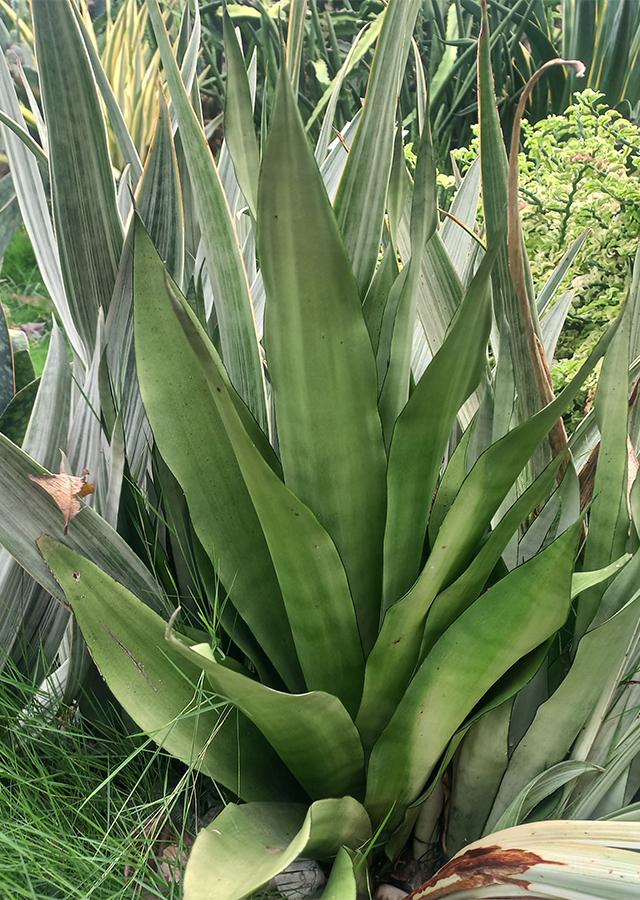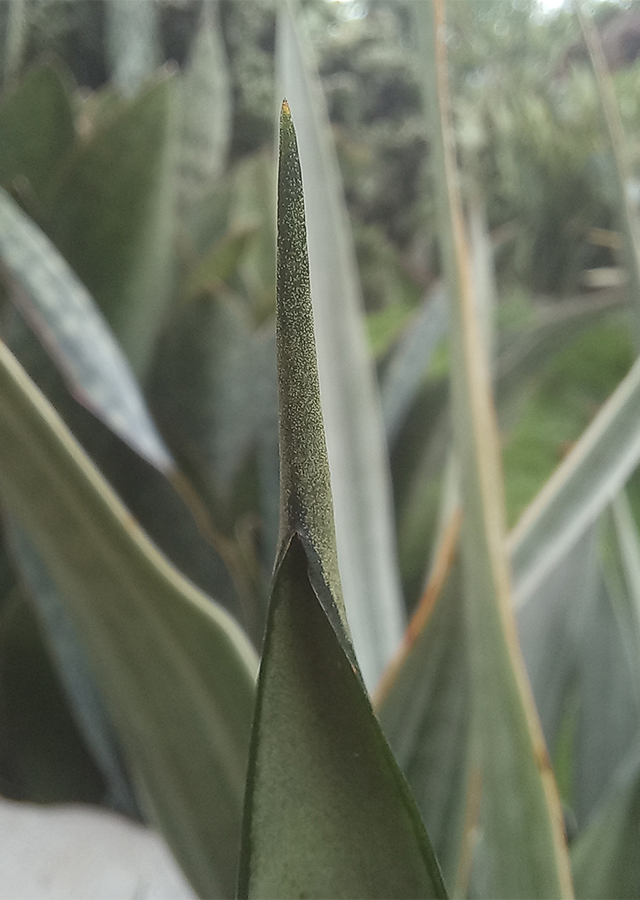Durango Soft Agave
Agave pedunculifera Trel.
Asparagaceae
Location in our garden
Principal



Synonym
Agave attenuata subsp. dentata (J.Verschaff.) B.Ullrich
Agave attenuata var. serrulata A.Terracc.
Agave cernua var. serrulata (A.Terracc.) A.Berger
Habitus
Succulent. A succulent, perennial plant that grows 60-90 cm tall.
Part Used
Leaves
Growing Requirements
Full Sunshine
Need Shade
Habitat
Forest
Mountains
Overview
Agave pedunculifera is native to the Mexican states of Sinaloa, Durango, Nayarit and Jalisco, where it can be found growing along sheer cliff faces of rocks that are of volcanic origin. This plant was first described under this name in 1920 by the American botanist, entomologist and explorer William Trelaese. It is most closely related to Agave attenuata, from which it differs in being more acaulescent (lacking a stem or trunk) and having small teeth on the leaf margin as compared to Agave attenuata which holds its rosettes of smooth margined leaves on long heavy stems that go both upright and outward to form a large clump. This succulent is usually planted in the garden as an ornamental plant, and is also useful in traditional medicine.
Vernacular Names
No found data on this. Need further research.
Agroecology
Grows in full sun to shade in a well-drained soil with regular to occasional irrigation. It likes a warm and dry environment and has an adaptable growth temperature of 15-25 ℃. At night, it grows best at a temperature of 10-16 ℃. It prefers a dry environment.
Morphology
- Leaves - forms mostly solitary rosettes to 120 cm wide with broad lance-shaped olive to bluish-green soft leaves that recurve back, 50-70 x 15-18 cm, or 80-90 x 11-15 cm.
- Flowers - spike racemose flowers, 2-3 m long, erect or curved, flowering close to the leaf crown; chartaceous bracts, very narrow, flowers germinate or crawl on dichotomous stalks 2-3 cm long, yellow, slender, 37-52 mm long; ovary 20-27 mm long slender, cylindrical, with a narrowed grooveless neck; shallow funnel-shaped tube, 2-6 mm deep, slightly wrinkled; tepals equal, oblong to elliptical, thin, ascending to obtuse, overlapping at base, wider inside (7-8 mm), with a broad low keel; filaments 30-55 mm long, anther 14-22 mm long, yellow centric.
- Fruit - capsules 15-20 mm long, apiculate.
- Seed - 2.5 × 2 mm.
Cultivation
- Vegetative propagation is by division (common method), which is usually carried out during growing seasons or when repotting. Carefully remove shoots that have sprouted from the leaves of the plant. If a removed shoot has roots and no wound at its base, it can be planted directly into a pot. If a removed shoot has no roots or has a wound, it will need to be placed in a cool and well-ventilated environment for about 5 days for the wound to fully dry and heal. After that, plant it in soil with good drainage and ventilation. It will generally take root in 10 days and survive.
- Generative propagation is by seed sowing, but it’s uncommon because it requires a long time to grow from a seedling to an adult plant.
Chemical Constituents
No found data on this. Need further research.
Traditional Medicinal Uses
Historical or theoretical uses which lack sufficient evidence: antibacterial, bruises, constipation, diabetes, diuretic, dysentery, flatulence, hair-restorer, hemolytic activities, indigestion, insulin resistance, jaundice, laxative, nutritional supplement, parasites, steroid source, swelling, Syndrome X. Further research or study is needed to confirm the traditional uses of this species.
Part Used
Reference Sources
- Hackman, D. A., et al. (2006). Agave (Agave americana): an evidence-based systematic review by the Natural Standard Research Collaboration. Journal of Herbal Pharmacotherapy 6(2):101-22. DOI:10.1080/J157v06n02_09.
- Howard Scott Gentry. 2004. Agaves of Continental North America - Halaman 80. The University of Arizona Press.
- Kew Royal Botanic Gardens. (No date). Plants of the World Online: Agave pedunculifera Trel. https://powo.science.kew.org/taxon/urn:lsid:ipni.org:names:6637-2#synonyms. 10-08-2022.
- Picture This. (No date). Agave attenuata subsp. dentata (Agave attenuata subsp. dentata) Care Guide Tuscon. https://www.picturethisai.com/care/Agave_attenuata_subsp._dentata.html. 10-08-2022.
- San Marcos Grower. (No date). Agave pedunculifera - Durango Soft Agave. https://www.smgrowers.com/products/plants/plantdisplay.asp?plant_id=3594.10-08-2022.
